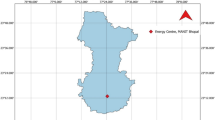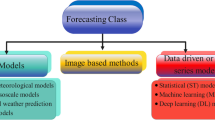Abstract
Increasing photovoltaic (PV) instalments could affect the stability of the electrical grid as the PV produces weather-dependent electricity. However, prediction of the power output of the PV panels or incoming radiation could help to tackle this problem. It has been concluded within the European Actions “Weather Intelligence for Renewable Energies” framework that more research is needed on short-term energy forecasting using different models, locations and data for a complete overview of all possible scenarios around the world representing all possible meteorological conditions. On the other hand, for the Mediterranean region, there is a need for studies that cover a larger spectrum of forecasting algorithms. This study focuses on forecasting short-term GHI for Kalkanli, Northern Cyprus, while aiming to contribute to ongoing research on developing prediction models by testing different hybrid forecasting algorithms. Three different hybrid models are proposed using convolutional neural network (CNN), long short-term memory (LSTM) and support vector regression (SVR), and the proposed hybrid models are compared with the performance of stand-alone models, i.e. CNN, LSTM and SVR, for the short-term GHI estimation. We present our results with several evaluation metrics and statistical analysis. This is the first time such a study conducted for GHI prediction.













Similar content being viewed by others
Explore related subjects
Discover the latest articles, news and stories from top researchers in related subjects.References
Ghimire S, Deo RC, Raj N, Mi J (2019) Deep solar radiation forecasting with convolutional neural network and long short-term memory network algorithms. Appl Energy 253:113541. https://doi.org/10.1016/j.apenergy.2019.113541
Demirtas M, Yesilbudak M, Sagiroglu S (2012) Colak I (2012) Prediction of solar radiation using meteorological data. Int Conf Renew Energy Res Appl ICRERA 2012:1–4. https://doi.org/10.1109/ICRERA.2012.6477329
Voyant C, Notton G, Kalogirou S et al (2017) Machine learning methods for solar radiation forecasting: a review. Renew Energy 105:569–582. https://doi.org/10.1016/j.renene.2016.12.095
Salcedo-Sanz S, Casanova-Mateo C, Pastor-Sánchez A, Sánchez-Girón M (2014) Daily global solar radiation prediction based on a hybrid coral reefs optimization - extreme learning machine approach. Sol Energy 105:91–98. https://doi.org/10.1016/j.solener.2014.04.009
Alzahrani A, Shamsi P, Dagli C, Ferdowsi M (2017) Solar irradiance forecasting using deep neural networks. In: Procedia computer science. Elsevier B.V., pp 304–313
Elliston B, MacGill I (2010) The potential role of forecasting for integrating solar generation into the Australian National Electricity Market. Sol 2010, Aust Sol Energy Soc, pp 1–11
Mazorra-Aguiar L, Díaz F (2018) Solar radiation forecasting with statistical models. In: Green energy and technology. Springer, pp 171–200
Von Appen J, Braun M, Stetz T et al (2013) Time in the sun: The challenge of high PV penetration in the German electric grid. IEEE Power Energy Mag 11:55–64. https://doi.org/10.1109/MPE.2012.2234407
Ferrari S, Lazzaroni M, Piuri V, et al (2012) Illuminance prediction through extreme learning machines. In: 2012 IEEE work environ energy, Struct Monit Syst EESMS 2012 - Proc 97–103. https://doi.org/10.1109/EESMS.2012.6348407
Fouilloy A, Voyant C, Notton G et al (2018) Solar irradiation prediction with machine learning: forecasting models selection method depending on weather variability. Energy 165:620–629. https://doi.org/10.1016/j.energy.2018.09.116
Qing X, Niu Y (2018) Hourly day-ahead solar irradiance prediction using weather forecasts by LSTM. Energy 148:461–468. https://doi.org/10.1016/j.energy.2018.01.177
Guariso G, Nunnari G, Sangiorgio M (2020) Multi-step solar irradiance forecasting and domain adaptation of deep neural networks. Energies 13:3987. https://doi.org/10.3390/en13153987
Voyant C, Muselli M, Paoli C, Nivet ML (2013) Hybrid methodology for hourly global radiation forecasting in Mediterranean area. Renew Energy 53:1–11. https://doi.org/10.1016/j.renene.2012.10.049
Fan J, Wang X, Wu L et al (2018) Comparison of support vector machine and extreme gradient boosting for predicting daily global solar radiation using temperature and precipitation in humid subtropical climates: a case study in China. Energy Convers Manag 164:102–111. https://doi.org/10.1016/j.enconman.2018.02.087
Lazzaroni M, Ferrari S, Piuri V et al (2015) Models for solar radiation prediction based on different measurement sites. Meas J Int Meas Confed 63:346–363. https://doi.org/10.1016/j.measurement.2014.11.037
Marquez R, Coimbra CFM (2011) Forecasting of global and direct solar irradiance using stochastic learning methods, ground experiments and the NWS database. Sol Energy 85:746–756. https://doi.org/10.1016/j.solener.2011.01.007
Yadav AK, Chandel SS (2014) Solar radiation prediction using Artificial Neural Network techniques: a review. Renew Sustain Energy Rev 33:772–781
Kong W, Dong ZY, Jia Y et al (2019) Short-term residential load forecasting based on lstm recurrent neural network. IEEE Trans Smart Grid 10:841–851. https://doi.org/10.1109/TSG.2017.2753802
Reikard G (2009) Predicting solar radiation at high resolutions: a comparison of time series forecasts. Sol Energy 83:342–349
Pedro HTC, Coimbra CFM (2015) Nearest-neighbor methodology for prediction of intra-hour global horizontal and direct normal irradiances. Renew Energy 80:770–782. https://doi.org/10.1016/j.renene.2015.02.061
Sözen A, Arcaklioglu E, Özalp M (2004) Estimation of solar potential in Turkey by artificial neural networks using meteorological and geographical data. Energy Convers Manag 45:3033–3052. https://doi.org/10.1016/j.enconman.2003.12.020
Krömer P, Musilek P, Pelikan E et al (2014) Support Vector Regression of multiple predictive models of downward short-wave radiation. Proc Int Jt Conf Neural Netw. https://doi.org/10.1109/IJCNN.2014.6889812
Lima FJL, Martins FR, Pereira EB et al (2016) Forecast for surface solar irradiance at the Brazilian Northeastern region using NWP model and artificial neural networks. Renew Energy 87:807–818. https://doi.org/10.1016/j.renene.2015.11.005
Cai S, Xie Y, Wu Q, Xiang Z (2020) Robust MPC-based microgrid scheduling for resilience enhancement of distribution system. Int J Electr Power Energy Syst 121:106068. https://doi.org/10.1016/J.IJEPES.2020.106068
Podestá GP, Núñez L, Villanueva CA, Skansi MA (2004) Estimating daily solar radiation in the Argentine Pampas. Agric For Meteorol 123:41–53. https://doi.org/10.1016/j.agrformet.2003.11.002
Aggarwal SK, Saini LM (2014) Solar energy prediction using linear and non-linear regularization models: a study on AMS (American Meteorological Society) 2013–14 Solar Energy Prediction Contest. Energy 78:247–256
Vakitbilir N, Hilal A, Direkoğlu C (2021) Prediction of daily solar irradiation using CNN and LSTM networks. Springer, Cham, pp 230–238
Zang H, Liu L, Sun L et al (2020) Short-term global horizontal irradiance forecasting based on a hybrid CNN-LSTM model with spatiotemporal correlations. Renew Energy 160:26–41. https://doi.org/10.1016/j.renene.2020.05.150
Wozniak M, Silka J, Wieczorek M, Alrashoud M (2021) Recurrent neural network model for IoT and networking malware threat detection. IEEE Trans Ind Inform 17:5583–5594. https://doi.org/10.1109/TII.2020.3021689
Woźniak M, Siłka J, Wieczorek M (2021) Deep neural network correlation learning mechanism for CT brain tumor detection. Neural Comput Appl 2021:1–16. https://doi.org/10.1007/S00521-021-05841-X
Zhong H, Wang J, Jia H et al (2019) Vector field-based support vector regression for building energy consumption prediction. Appl Energy 242:403–414. https://doi.org/10.1016/J.APENERGY.2019.03.078
Zhang F, Deb C, Lee SE et al (2016) Time series forecasting for building energy consumption using weighted Support Vector Regression with differential evolution optimization technique. Energy Build 126:94–103. https://doi.org/10.1016/J.ENBUILD.2016.05.028
Niu XX, Suen CY (2012) A novel hybrid CNN–SVM classifier for recognizing handwritten digits. Pattern Recognit 45:1318–1325. https://doi.org/10.1016/J.PATCOG.2011.09.021
Tao QQ, Zhan S, Li XH, Kurihara T (2016) Robust face detection using local CNN and SVM based on kernel combination. Neurocomputing 211:98–105. https://doi.org/10.1016/J.NEUCOM.2015.10.139
Khosravi A, Koury RNN, Machado L, Pabon JJG (2018) Prediction of hourly solar radiation in Abu Musa Island using machine learning algorithms. J Clean Prod 176:63–75. https://doi.org/10.1016/j.jclepro.2017.12.065
Belaid S, Mellit A (2016) Prediction of daily and mean monthly global solar radiation using support vector machine in an arid climate. Energy Convers Manag 118:105–118. https://doi.org/10.1016/j.enconman.2016.03.082
Ilkan M, Erdil E, Egelioglu F (2005) Renewable energy resources as an alternative to modify the load curve in Northern Cyprus. Energy 30:555–572. https://doi.org/10.1016/j.energy.2004.04.059
Zang H, Cheng L, Ding T et al (2018) Hybrid method for short-term photovoltaic power forecasting based on deep convolutional neural network. IET Gener Transm Distrib 12:4557–4567. https://doi.org/10.1049/iet-gtd.2018.5847
Wang F, Zhang Z, Liu C et al (2019) Generative adversarial networks and convolutional neural networks based weather classification model for day ahead short-term photovoltaic power forecasting. Energy Convers Manag 181:443–462. https://doi.org/10.1016/j.enconman.2018.11.074
Gu J, Wang Z, Kuen J et al (2018) Recent advances in convolutional neural networks. Pattern Recognit 77:354–377. https://doi.org/10.1016/j.patcog.2017.10.013
Burkov A (2019) The hundred-page machine learning book
Conv1D layer. https://keras.io/api/layers/convolution_layers/convolution1d/. Accessed 14 Feb 2021
Hochreiter S, Schmidhuber J (1997) Long Short-Term Memory. Neural Comput 9:1735–1780. https://doi.org/10.1162/neco.1997.9.8.1735
Gers FA, Schmidhuber J, Cummins F (1999) Learning to forget: continual prediction with LSTM. In: IEEE conference publication. IEEE, pp 850–855
Awad M, Khanna R (2015) Support vector regression. Effic Learn Mach. https://doi.org/10.1007/978-1-4302-5990-9_4
Müller KR, Smoła AJ, Rätsch G, et al (1997) Predicting time series with support vector machines. In: Lecture notes in computer science (including subseries lecture notes in artificial intelligence and lecture notes in bioinformatics). Springer, pp 999–1004
Wauters M, Vanhoucke M (2014) Support Vector Machine Regression for project control forecasting. Autom Constr 47:92–106. https://doi.org/10.1016/j.autcon.2014.07.014
Deo RC, Wen X, Qi F (2016) A wavelet-coupled support vector machine model for forecasting global incident solar radiation using limited meteorological dataset. Appl Energy 168:568–593. https://doi.org/10.1016/j.apenergy.2016.01.130
Kleynhans T, Montanaro M, Gerace A, Kanan C (2017) Predicting top-of-atmosphere thermal radiance using MERRA-2 atmospheric data with deep learning. Remote Sens 9:1133. https://doi.org/10.3390/rs9111133
Mohammadi K, Shamshirband S, Anisi MH et al (2015) Support vector regression based prediction of global solar radiation on a horizontal surface. Energy Convers Manag 91:433–441. https://doi.org/10.1016/j.enconman.2014.12.015
Gensler A, Henze J, Sick B, Raabe N (2017) Deep Learning for solar power forecasting - An approach using AutoEncoder and LSTM Neural Networks. In: 2016 IEEE international conference on systems, man, and cybernetics, SMC 2016 - conference proceedings. Institute of electrical and electronics engineers Inc., pp 2858–2865
Inman RH, Pedro HTC, Coimbra CFM (2013) Solar forecasting methods for renewable energy integration. Prog Energy Combust Sci 39:535–576
Goodwin P, Lawton R (1999) On the asymmetry of the symmetric MAPE. Int J Forecast 15:405–408. https://doi.org/10.1016/S0169-2070(99)00007-2
Makridakis S (1993) Accuracy measures: theoretical and practical concerns. Int J Forecast 9:527–529. https://doi.org/10.1016/0169-2070(93)90079-3
Tofallis C (2015) A better measure of relative prediction accuracy for model selection and model estimation. J Oper Res Soc 66:1352–1362. https://doi.org/10.1057/jors.2014.103
Russell S, Norvig P (2009) Artificial intelligence: a modern approach, 3rd edn. Prentice Hall Press, One Lake Street Upper Saddle River
Sanner MF (1999) Python: a programming language for software integration and development. J Mol Graph Model 17:57–61
Ketkar N, Ketkar N (2017) Introduction to Keras. In: Deep learning with python. A Press, pp 97–111
Abadi M, Barham P, Chen J, et al (2016) TensorFlow: A system for large-scale machine learning. In: Proceedings of 12th USENIX symposium on operating systems design implementation, OSDI 2016, pp 265–283
Pedregosa F, Varoquaux G, Gramfort A et al (2011) Scikit-learn: Machine learning in Python. J Mach Learn Res 12:2825–2830
Wozniak M, Wieczorek M, Silka J, Polap D (2021) Body pose prediction based on motion sensor data and recurrent neural network. IEEE Trans Ind Inform 17:2101–2111. https://doi.org/10.1109/TII.2020.3015934
Lehmann EL, Romano JP (2005) Testing statistical hypotheses, 3rd edn. Springer, New York
Funding
No funding was received for conducting this study.
Author information
Authors and Affiliations
Corresponding author
Ethics declarations
Conflict of interest
The authors declare that they have no conflict of interest.
Additional information
Publisher's Note
Springer Nature remains neutral with regard to jurisdictional claims in published maps and institutional affiliations.
Rights and permissions
About this article
Cite this article
Vakitbilir, N., Hilal, A. & Direkoğlu, C. Hybrid deep learning models for multivariate forecasting of global horizontal irradiation. Neural Comput & Applic 34, 8005–8026 (2022). https://doi.org/10.1007/s00521-022-06907-0
Received:
Accepted:
Published:
Issue Date:
DOI: https://doi.org/10.1007/s00521-022-06907-0




